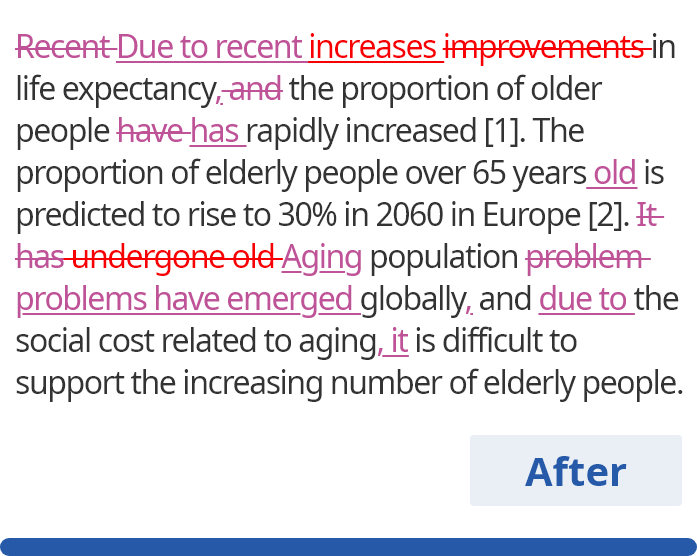主語と動詞の一致
センテンス中の主語と動詞は数の上で常に一致していなければなりません。単数形の主語には単数動詞、複数形の主語には複数動詞を使います。どの名詞が主語なのかに関して読み手を混乱させないために、主語と動詞の人称を一致させることは大切です。
- Example
- The girl is walking in the park.
上記は単文で、センテンスの主語が「girl」であることは読み手にも明確です。単数動詞の「is」は、単数形の主語「girl」と数の上で一致しています。
しかし、より複雑なセンテンスの場合にはこれほど明快ではありません。以下の例を見てみましょう。
- Incorrect
- Sample 1, in addition to Samples 2 and 3, were found to be contaminated.
- Correct
- Sample 1, in addition to Samples 2 and 3, was found to be contaminated.
ここでの主語は「Sample 1」ですが、もしこのセンテンスで複数動詞の「were」が使われていたら、読み手は、このセンテンスの主語は「Sample 1」だけでなく「Sample 2」と「Sample 3」も主語であると考えるのが自然でしょう。
主語-動詞ペアの例
| 動詞 | 単数形の 主語 + 動詞 | 複数形の 主語 + 動詞 |
|---|---|---|
|
Be |
The study is novel. |
The studies are novel. |
|
Make |
He makes a cake. |
They make a cake. |
|
Conclude |
Goldmund concludes that 67% of the samples had been contaminated. |
Goldmund and Millstein conclude that 67% of the samples had been contaminated. |
|
Present |
The figure presents the results of the simulation. |
The figures present the results of the simulation. |
目次
複主語と動詞
センテンス中、1つの動詞に対して主語が複数ある可能性もあります。2つ以上の主語が1つの動詞を共有する場合、それら主語は「and」または「or」という接続詞で結ばれます。接続詞の「and」で結ばれた主語には常に複数動詞を使います。
- Incorrect
- Composite A and composite C was discarded due to surface irregularities.
- Correct
- Composite A and composite C were discarded due to surface irregularities.
反対に、「(either…)or」という接続詞で結ばれた2つ以上の単数形の主語には、単数動詞を使います。
- Incorrect
- We concluded that either composite A or composite C have issues with surface irregularity.
- Correct
- We concluded that either composite A or composite C has issues with surface irregularity.
「(neither…)nor」という接続詞で結ばれた2つ以上の単数形の主語の場合も同様のルールに従います。
- Incorrect
- Neither sample B nor sample D were found to be contaminated.
- Correct
- Neither sample B nor sample D was found to be contaminated.
ただし、結ばれた主語が複数形の場合には、複数動詞を使わなければなりません。
- Incorrect
- Neither the patients in group A nor the patients in group B has histories of illness.
- Correct
- Neither the patients in group A nor the patients in group B have histories of illness.
複主語には、単数形と複数形の名詞の両方が含まれることも時にはあります。この場合、動詞はその一番近くにある名詞の形態に一致させます。
- Incorrect
- Neither the main frame of the vehicle nor its additional components needs to be treated with the solution.
- Correct
- Neither the main frame of the vehicle nor its additional components need to be treated with the solution.
「components」が複数名詞であるため、単数動詞の「need」がここでは使われています。
「and」で結ばれた2つ以上の主語に関する追加の例文
「and」で結ばれた2つ以上の主語には複数動詞を使います。
- Example
- The puppy and the kitten are friends.
- Example
- The behaviors of lipids and proteins were studied in an isolated environment.
「(either…)or」または「(neither…)nor」で結ばれた2つ以上の主語に関する追加の例文
「(either….) or」または「(neither…) nor」で結ばれた単数形の2つ以上の主語には単数動詞を使います。
- Example
- Either the vacuum chamber or the clean room has been damaged.
- Example
- Neither the vacuum chamber nor the clean room has been damaged.
「(either…) or」または「(neither…) nor」で結ばれた複数形の2つ以上の主語には複数動詞を使います。
- Example
- Either he or she waters the plants.
- Example
- It is rainy, so neither the park nor the beach is nice to walk on.
単数形と複数形の名詞の両方を含む複主語に対する動詞は、その一番近くにある名詞の形態と一致させます。「or」または「nor」で結ばれた2つ以上の名詞のうちの1つが複数形の場合、動詞も複数形にして、複数形の主語はその動詞の隣に置きます。
- Example
- Either he or his daughters water the plants.
- Example
- Neither the clean room nor the vacuum chambers have been damaged.
切り離された主語と動詞
多くのセンテンスには、主語と動詞を切り離すフレーズや節が含まれています。このような場合、主語を見つけるのが困難になってきます。以下の2つのセンテンスの例を見てみましょう。
- (a)
- Many studies on this subject has neglected the effect of oxygen on the fabrication process.
- (b)
- Many studies on this subject have neglected the effect of oxygen on the fabrication process.
どちらのセンテンスが正しいでしょうか?正解はbです。このセンテンスの主語は「studies」であり、「subject」は主語ではありません。正しい動詞形を使えば、読み手があなたの文章の主語を正確に識別できるようになります。
- Incorrect
- We found that the derivatives of C demonstrates high heat resistance.
- Correct
- We found that the derivatives of C demonstrate high heat resistance.
正しい複数動詞を使うことで、2つ目のセンテンスの主語は「derivatives」であることが明確になります。
その他のコネクター:「along with」「as well as」「in addition to」
「along with」「as well as」「in addition to」といったフレーズは接続詞ではありませんが、コネクターの役目を果たしています。上記したように、接続詞「and」で結ばれた2つ以上の主語は常に複数動詞と一緒に使います。ただし、「along with」「as well as」「in addition to」が使われている場合、このルールは当てはまりません。
- Incorrect
- Composite C, along with composite A, were discarded due to surface irregularities.
- Correct
- Composite C, along with composite A, was discarded due to surface irregularities.
- Incorrect
- Composite C as well as composite A were discarded due to surface irregularities.
- Correct
- Composite C as well as composite A was discarded due to surface irregularities.
- Incorrect
- Composite C, in addition to composite A, were discarded due to surface irregularities.
- Correct
- Composite C, in addition to composite A, was discarded due to surface irregularities.
コネクター・フレーズが「and」と異なるのは、コネクター・フレーズを用いても複主語が形成されない点です。上記センテンスでは、主語は「composite C」であって、「composite C, along with composite A」「“composite C as well as composite A」「composite C, in addition to composite A」のいずれでもではありません。
不定代名詞
「anything」などの不定代名詞には、単数動詞または複数動詞のどちらを使うのか迷うことが多いでしょう。常に単数形として扱われる不定代名詞がある一方、常に複数形扱いされるものもあります。いくつかのこれら代名詞は、センテンスによって扱いが単数形だったり複数形だったりします。以下は、よく使われる不定代名詞のリストです。
all, any, anything, anybody, anyone, anywhere, every, everything, everybody, everyone, everywhere, some, something, somebody, someone, somewhere, none, nothing, nobody, nowhere, more, most, another, each, one, both, either, few, many, several
不定代名詞のほとんどは単数扱いされます。「Every」「another」「each」「one」、および語尾が「thing」「body」「one」「where」で終わる不定代名詞は、単数動詞と一緒に使います。
- Example
- Every sample was treated with the prepared solution.
- Example
- Another girl asks for paper.
- Example
- Each of the samples was treated with the prepared solution.
- Example
- Only one of the boys wants ice cream.
- Example
- Something is wrong.
一方、「both」「few」「many」「several」は複数として扱われます。
- Example
- Both of the samples were contaminated with ammonia.
- Example
- Few are happy with the results.
- Example
- We found that many of the composites were damaged by exposure to air.
- Example
- Several children look for extra pencils.
不定代名詞の中には、センテンスにより、その扱いが単数形だったり複数形だったりするものがいくつかあります。「all」「some」「any」「none」「more」「most」「either」がその例です。不定代名詞「some」を使った以下のセンテンスを見ていきましょう。
- Example
-
Some of the samples were contaminated.
Some of the sample was contaminated.
1つ目のセンテンスでは、「some」が複数形である「samples」にかかっているため複数動詞を使います。2つ目のセンテンスの場合、「some」は単数形である「sample」にかかっているため、単数動詞と共に使わなければなりません。
動詞のあとにくる主語
センテンスのなかには、主語-動詞の順ではなく、動詞の後に主語がくるパターンもあります。「there」や「here」で始まるセンテンスや、倒置構文となったセンテンスがこれに当てはまります。
- Example
- There are five equations that must be considered.
- Example
- Here is an equation that must be considered.
- Example
- Behind the building stands a trash can.
上記の例でわかるように、主語-動詞の人称一致ルールは、主語が動詞の後にくるセンテンスにも同様に適用されます。
数字・比率・金額が主語となっている場合
数字や数量がセンテンスの主語となっている場合もあります。通常、科学研究において数値は大切な要素であるため、このようなケースはアカデミックライティングでは特によく見られます。主語となっている数値に一致させる正しい動詞の形態は、その数値が何に言及しているかによります。
- Example
- 67% of the samples were found to be contaminated.
- Example
- 80 cm of electric tape was cut.
「67%」は「samples」(複数形)にかかっているため、複数動詞である「were」を使います。一方、「80 cm」は「electrical tape」(単数形)にかかっているため、単数動詞「was」を使います。比率がが主語である場合にも同様なルールが当てはまります。
- Example
- Almost three-quarters of the samples were found to be contaminated.
- Example
- Almost three-quarters of the first sample was found to be contaminated.
主語が、何かを一つにまとめた数量の際には、単数として扱うべきです。
- Example
- 70 cm is not a sufficient length.
- Example
- 97.5% is a high accuracy that has not been previously achieved.
集合名詞が主語となっている場合
集合名詞とは、人・動物・物の統一グループを指しています。このような名詞に一致させる動詞の形態はアメリカ英語かイギリス英語かで違ってきます。アメリカ英語では、集合名詞は一般的に単数扱いしますが、イギリス英語では複数として扱います。
- Example
- (US) The flock flies to Russia in early summer.
- Example
- (UK) The flock fly to Russia in early summer.
「flock」とは鳥の群れのことです。アメリカ英語の慣習として「flock」は単数動詞と共に使われます。一方、イギリス英語では、「flock」は複数動詞と共に用いると決められています。アメリカ英語は、群れの統一性に注視しているのに対し、イギリス英語の場合は群れを成している多数の鳥に注視しているからです。
集合名詞が単数扱いか、または複数扱いかは、センテンスの内容により見極めるため「Emphasis(注視)」がここでのキーワードとなっています。
- Example
- The flock squawk at each other.
- Example
- The flock is enormous.
上の例では、二つの文章の注視する部分が異なります。
不可算名詞が主語となっている場合
不可算名詞は曖昧な概念、または総括的用語であるため、数えられません。以下は不可算名詞の例です。
research, information, progress, equipment, furniture, luggage, flour, cement
不可算名詞には常に単数動詞を組み合わせます。
- Example
- The research found the previous results to be invalid.
- Example
- Information is a strategic resource.
- Example
- The cement was poured over the foundation.
頭文字略語(アクロニム)と略語が主語となっている場合
アクロニムと略語に関するルールは簡潔です。略されている語の元の単語を確認します。まず、単語のフルバージョンが単数、複数、複合形、集合形のいずれかを確かめ、それぞれに適応されるルールを当てはめます。
- Example
- This new SSD is perfect for my PC.
「SSD」は「solid-state drive」を意味していて、これは単数形であるため、単数動詞を使います。
- Example
- BCS continue to experience the side effects of the treatments they were exposed to.
「BCS」は「breast cancer survivors」を意味していて、これは複数形であるため、複数動詞を使います。













